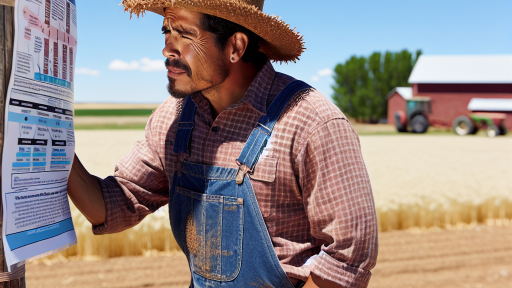Understanding the Types of Farm Aid Available
Federal Programs
Farm aid often starts with federal programs.
The U.S. Department of Agriculture (USDA) offers several assistance programs.
These include grants, loans, and insurance options.
Each program addresses different agricultural challenges.
Farmers should research which program fits their needs.
State-Level Assistance
In addition to federal aid, many states provide their own programs.
State-level assistance can include grants, subsidies, and tax relief.
Horizon Farms, for example, benefits from local grants.
Farmers should check their state’s agricultural department website for options.
Each state tailors its programs to local agricultural needs.
Nonprofit and Private Sector Organizations
Numerous nonprofits assist farmers through various programs.
Organizations like the Farm Bureau offer educational resources.
They may also provide direct financial assistance or advocacy.
Collaborating with these groups can yield valuable support.
Examples include the National Farmers Union and local co-ops.
Transform Your Agribusiness
Unlock your farm's potential with expert advice tailored to your needs. Get actionable steps that drive real results.
Get StartedSpecialty Crop Programs
Some aid focuses specifically on specialty crops.
These crops, such as fruits and vegetables, require unique support.
Programs exist to help with marketing and production challenges.
The Specialty Crop Block Grant Program is an example.
Farmers growing specialty crops should explore these targeted options.
Disaster Relief Programs
Natural disasters can severely affect agriculture each year.
Disaster relief programs provide immediate support to impacted farmers.
Federal Emergency Management Agency (FEMA) offers aid during such times.
In addition, USDA’s Farm Service Agency disburses emergency funds.
Farmers must act quickly to access these critical resources.
Common Misunderstandings About Eligibility Requirements
Defining Eligibility Criteria
Many applicants misunderstand the eligibility criteria for farm aid programs.
Each program has specific requirements depending on the type of aid offered.
Generally, applicants must demonstrate a commitment to active farming.
In addition, they need to provide proof of income and farm operation details.
Income Thresholds and Requirements
Income thresholds can vary significantly among different aid programs.
Some applicants assume they exceed the limits without checking.
It’s essential to review the specific income guidelines for each program.
Moreover, some applicants overlook deductions that could impact income calculations.
Types of Eligible Farms
Another common misconception is about which types of farms qualify.
Some believe only large operations are eligible for aid.
In reality, small family farms often qualify as well.
Additionally, organic farms may receive support that conventional farms do not.
Filing Deadlines and Their Importance
Applicants frequently misjudge the deadlines for submitting applications.
Each program has unique timelines that must be adhered to strictly.
Showcase Your Farming Business
Publish your professional farming services profile on our blog for a one-time fee of $200 and reach a dedicated audience of farmers and agribusiness owners.
Publish Your ProfileMissing a deadline can disqualify an applicant from receiving aid.
Thus, it is vital to keep track of these deadlines carefully.
Documentation Requirements
Insufficient documentation is a leading cause of rejected applications.
Many applicants overlook the necessary paperwork needed for verification.
It’s crucial to include all required documents, such as tax returns and farm records.
Also, missing signatures or incomplete forms can lead to delays.
Misinformation About Program Changes
Farm aid programs often evolve, leading to confusion among applicants.
Some applicants rely on outdated information when applying for aid.
Therefore, staying updated on program changes is essential.
Review official resources regularly to ensure accurate information.
Neglecting to Keep Detailed Records and Documentation
Importance of Record Keeping
Detailed records are essential for farm aid applications.
Without them, farmers may struggle to prove eligibility.
Accurate documentation can simplify the application process.
Moreover, it facilitates transparency with aid organizations.
Common Types of Records to Maintain
Farmers should keep several important records.
Financial statements document income and expenses.
Production records track yields and crop performance.
Labor records show hours and wages paid to workers.
Equipment and maintenance logs provide service history.
Best Practices for Record Keeping
Establish a system for organizing records.
Use digital tools to store and manage documentation.
Regularly review and update records to maintain accuracy.
Additionally, ensure backup copies exist in case of loss.
Consequences of Poor Record Keeping
Poor record keeping can lead to application denials.
Farmers may miss out on valuable funding opportunities.
Incomplete documentation can complicate audits and reviews.
Ultimately, it can undermine the credibility of the farm.
Discover More: Benefits of Government Aid for Farmers
Failing to Meet Application Deadlines and Submission Requirements
Understanding the Importance of Deadlines
Deadlines are critical in the farm aid application process.
Missing a deadline can lead to rejection.
Therefore, it’s essential to keep track of submission dates.
Always note the deadlines as soon as they are announced.
Use a calendar or planner to stay organized.
Common Reasons for Missing Deadlines
Farmers often face various challenges that result in missed deadlines.
Some common reasons include poor planning and last-minute issues.
Additionally, unforeseen circumstances can cause delays.
It may also stem from a lack of awareness about the requirements.
Regularly reviewing the application process can help mitigate this risk.
Best Practices for Meeting Submission Requirements
Thoroughly review application instructions before starting.
Ensure that all required documents are gathered in advance.
Showcase Your Farming Business
Publish your professional farming services profile on our blog for a one-time fee of $200 and reach a dedicated audience of farmers and agribusiness owners.
Publish Your ProfileDouble-check for completeness before submission.
Use checklists to keep track of necessary items.
Consider reaching out to local agricultural offices for assistance.
Consequences of Late Applications
Submitting applications late often results in disqualification.
This can lead to lost opportunities for financial support.
Furthermore, it can impact the farm’s overall financial stability.
Always prioritize timely application submissions to avoid these pitfalls.
Gain More Insights: How New Trade Policies Are Impacting U.S. Farmers and Exports
Not Researching Specific Programs and Their Benefits
Understanding Available Farm Aid Options
Many farmers overlook the variety of farm aid programs available.
However, each program offers unique benefits tailored to different needs.
Farmers should first identify which programs suit their specific situation.
For instance, disaster relief programs support those affected by natural disasters.
On the other hand, conservation programs focus on sustainable farming practices.
Benefits of Thorough Research
Research helps farmers avoid common pitfalls associated with applications.
By understanding program requirements, they can better align their applications.
Moreover, knowing the benefits allows farmers to maximize available resources.
This knowledge can lead to more successful funding outcomes.
Examples of Misunderstanding Program Details
Many applicants fail to review the eligibility criteria carefully.
Consequently, they waste time applying for programs they cannot access.
For example, a dairy farmer might apply for crop assistance erroneously.
Such mistakes often delay needed financial support.
Importance of Staying Updated
Farm aid programs evolve regularly, impacting their criteria and benefits.
Thus, farmers must keep abreast of any changes to these programs.
Additionally, understanding funding cycles ensures timely applications.
This proactive approach can significantly enhance their chances of success.
Explore Further: Navigating New Water Rights Policies: What It Means for Farmers

Overlooking the Importance of Personal Statements and Justifications
Many applicants underestimate personal statements in their farm aid applications.
Neglecting this crucial section can lead to missed opportunities.
A strong personal statement presents an applicant’s unique situation.
It highlights why they deserve assistance over others.
Crafting a Compelling Personal Statement
The personal statement should tell a story about the applicant’s farming journey.
For instance, detailing challenges faced adds depth to the application.
Applicants should include information on their farm’s history.
Additionally, discussing future goals can help convey aspirations.
Being authentic and heartfelt is essential in this section.
Furthermore, using specific examples makes the statement memorable.
Justifications for Requesting Aid
Justifications clarify the need for financial assistance.
Applicants must outline specific circumstances that necessitate aid.
This could include natural disasters impacting crop yield.
Additionally, changes in market conditions may affect their operation.
Showcase Your Farming Business
Publish your professional farming services profile on our blog for a one-time fee of $200 and reach a dedicated audience of farmers and agribusiness owners.
Publish Your ProfileFarmers should also consider including data to support their claims.
For instance, statistical evidence can strengthen arguments.
Avoiding Common Pitfalls
Common mistakes include vague statements lacking detail.
Applicants should avoid generic reasons for requesting aid.
Using jargon may confuse reviewers and diminish clarity.
Additionally, failing to proofread can lead to careless errors.
Such mistakes can undermine an applicant’s credibility.
Finally, not adhering to guidelines may result in disqualification.
Learn More: Everything You Need to Know About Water Use Regulations in California
Ignoring the Role of Local Extension Services and Advisors
Understanding Local Extension Services
Local extension services play a critical role in agriculture.
They offer farmers access to vital resources and information.
Farmers can obtain advice tailored to their specific needs.
Additionally, these services help bridge the gap between research and practice.
Benefits of Consulting Advisors
Consulting with local agricultural advisors brings numerous advantages.
Advisors provide insights based on regional conditions and trends.
Moreover, they help in identifying eligible funding opportunities.
This support can enhance the success rate of farm aid applications.
Common Pitfalls in Neglecting Local Resources
Avoiding local extension resources leads to missed opportunities.
Farmers who disregard this support may lack critical guidance.
This oversight can result in incomplete or inaccurate applications.
Consequently, farmers may face delays in receiving necessary aid.
Strategies for Effective Engagement
Farmers should actively engage with local extension services.
Regularly attending workshops enhances knowledge and skills.
Furthermore, establishing a relationship with advisors fosters trust.
Cultivating this connection allows farmers to receive timely assistance.
Success Stories from Local Advisors
Many farmers have achieved success by leveraging local advisors.
For instance, Maria Sosa improved her yield through expert guidance.
Similarly, James Thompson received crucial aid application support.
These examples highlight the value of local resources in farming success.
Submitting Incomplete Applications or Misaligning with Guidelines
Understanding Application Requirements
Each farm aid program has specific application requirements.
Read the guidelines carefully before starting your application.
This helps ensure you include all necessary information.
Often, applicants overlook essential documents needed for submission.
Common Documentation Mistakes
Incomplete financial statements can jeopardize your application.
Ensure you provide up-to-date and accurate information.
Omitting farm inventory information often results in delays.
Verify that all forms are signed and dated appropriately.
Aligning with Program Guidelines
Many applicants misalign their objectives with program goals.
Familiarize yourself with the program’s purpose and focus.
Tailor your application to showcase how you meet these aims.
Showcase Your Farming Business
Publish your professional farming services profile on our blog for a one-time fee of $200 and reach a dedicated audience of farmers and agribusiness owners.
Publish Your ProfileBeing vague about your goals can lead to rejection.
Checking for Errors Before Submission
Take the time to review your application thoroughly.
Spelling and grammatical mistakes can undermine your credibility.
Consider asking a colleague to proofread your application.
A fresh set of eyes often identifies overlooked errors.
Importance of Deadlines
Missing deadlines is a significant mistake in farm aid applications.
Mark key dates on your calendar and set reminders.
Submitting your application late can result in disqualification.
Make sure all materials are ready well in advance of the due date.




